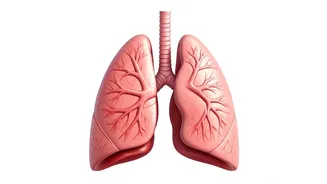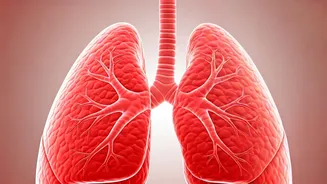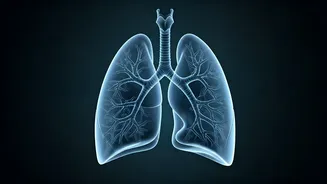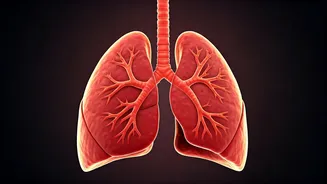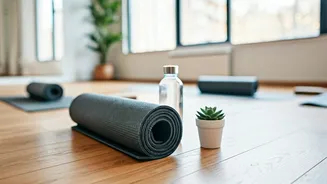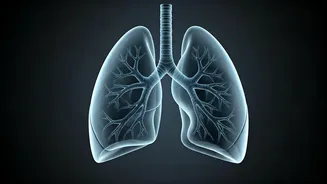Yoga's Respiratory Boost
Yoga, particularly when practiced consistently, offers remarkable benefits for lung health. During Diwali, with its increased air pollution, maintaining
good respiratory function is crucial. Regular practice can enhance lung capacity and improve overall breathing efficiency. Several yoga asanas, or poses, can be especially effective. Techniques like deep, controlled breathing are key, helping to expand the lungs and increase oxygen intake. These exercises can counter the effects of poor air quality and festive activities, promoting a healthier respiratory system. Yoga's focus on mindfulness also aids in managing stress, which can indirectly impact breathing patterns. Incorporating yoga into your daily routine is a proactive step toward a healthier lifestyle, supporting both physical and mental well-being during Diwali and beyond. The consistent practice offers long-term benefits, strengthening the lungs and improving the body's ability to cope with environmental stressors.
Essential Yoga Poses
Several yoga poses are particularly beneficial for strengthening the lungs. The Cobra Pose (Bhujangasana), involves lying on your stomach and lifting your chest off the floor, opening the chest and stimulating the lungs. The Triangle Pose (Trikonasana) is also advantageous; this pose expands the chest, encouraging deeper breathing. Another excellent pose is the Seated Twist (Ardha Matsyendrasana), which aids in detoxifying the body and enhancing breathing by improving spinal flexibility. The Bridge Pose (Setu Bandhasana) is also significant as it expands the chest, thereby promoting better oxygen intake. These poses should be practiced with awareness, focusing on slow, deliberate movements and deep breaths. Performing these asanas consistently helps to improve lung capacity and overall respiratory function. Remember to listen to your body and avoid pushing beyond your limits. Beginners should start with shorter durations and gradually increase the time as they become more comfortable. Proper alignment is also essential to maximize the benefits and prevent injuries.
Diwali Breathing Exercises
Specific breathing exercises, known as pranayama, can greatly improve lung health during Diwali. Diaphragmatic breathing, or belly breathing, is a simple yet effective technique. Inhale deeply, allowing your belly to expand, and exhale slowly, feeling the abdomen contract. This type of breathing engages the diaphragm, leading to increased lung capacity. Another vital exercise is the Alternate Nostril Breathing (Nadi Shodhana). This technique involves using one nostril at a time to inhale and exhale, promoting balance within the body and reducing stress, which benefits breathing. The Lion's Breath (Simhasana) can also be incorporated to release tension in the chest and throat, thereby improving airflow. Practicing these breathing exercises regularly helps to cleanse the lungs and improves oxygen absorption. Consistent practice contributes to greater lung capacity and efficiency, which is especially beneficial during times of increased pollution. It's important to start slowly and gradually increase the duration of each exercise as comfort levels increase.
Creating a Routine
To gain maximum benefit, integrating these practices into a daily 10-minute routine is ideal. Begin with a few minutes of gentle stretching to warm up the body. Then, practice the yoga poses for a set duration, ensuring proper form. Follow this with the selected breathing exercises, paying close attention to the breath. Conclude the session with a few minutes of relaxation, focusing on the breath. Consistency is vital; practicing daily will yield the best results. A well-structured routine helps the body to adapt and improve over time. Finding a quiet space and setting a specific time each day helps to create a habit. Modifications can be made to suit individual needs and comfort levels. For instance, those with limited mobility can adapt poses to a seated position. If you are a beginner, it is advisable to start with shorter durations of each pose and breathing exercise and gradually increase as your fitness improves. This allows the body to adapt gradually.
Benefits of Consistency
The advantages of a consistent yoga and breathing practice extend beyond the immediate improvements in lung health. Regular practice enhances overall well-being. It reduces stress and anxiety, which can negatively affect respiratory function. Improved breathing helps to oxygenate the body more efficiently, increasing energy levels. A regular yoga routine improves posture and flexibility, contributing to physical health. Additionally, mindfulness, which is an integral aspect of yoga and pranayama, promotes a sense of calm and mental clarity. By practicing consistently, individuals can build a strong foundation for both physical and mental health. This daily ritual serves as a proactive measure against respiratory ailments, especially during times of heightened air pollution. Sustained commitment fosters a healthier lifestyle and supports long-term well-being, enhancing both physical and mental resilience. The benefits extend beyond the practice itself, positively influencing various aspects of daily life.
